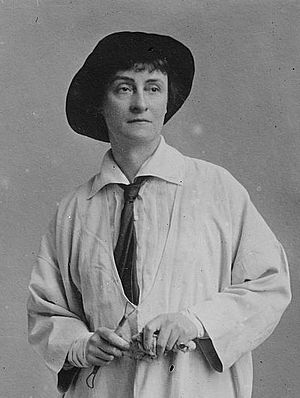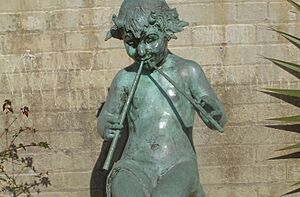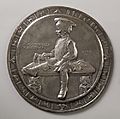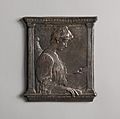Janet Scudder facts for kids
Quick facts for kids
Janet Scudder
|
|
|---|---|
 |
|
| Born | October 27, 1869 |
| Died | June 9, 1940 (aged 70) |
| Education | Rose Polytechnic Institute of Technology, Cincinnati Art Academy, Académie Colarossi |
| Known for | Sculpture |
Janet Scudder (born Netta Deweze Frazee Scudder, October 27, 1869 – June 9, 1940) was an American sculptor and painter. She was born in Terre Haute, Indiana. Janet Scudder is famous for her memorial sculptures and special bas-relief portraits. She also created beautiful garden sculptures and fountains.
One of her first big projects was designing a seal for the New York Bar Association around 1896. Her sculpture called Frog Fountain (1901) became very popular. It led to many other famous fountains and sculptures. She also designed a Congressional Gold Medal and a special medal for Indiana's 100th birthday in 1916. Janet Scudder showed her artwork in many exhibitions in the United States and Europe. Her life story, Modeling My Life, was published in 1925.
Scudder studied art at the Cincinnati Art Academy and the Art Institute of Chicago. She also learned from famous sculptors like Lorado Taft and Frederick W. MacMonnies in Paris, France. Janet Scudder was a strong supporter of women's suffrage, which means women's right to vote. She was part of the New York State Woman Suffrage Association. In 1925, France honored her with the French Legion of Honor award. This was for her help as a Red Cross volunteer during World War I.
Janet Scudder won several awards for her art. These included bronze and silver medals at big international exhibitions. Her sculptures are now in many famous museums. You can find them in places like the Musée d'Orsay in France and the Metropolitan Museum of Art in the United States.
Contents
Early Life and Art Training
Janet Scudder was born on October 27, 1869, in Terre Haute, Indiana. Her birth name was Netta Deweze Frazee Scudder. She was the fifth of seven children. Janet had a tough childhood, losing her mother when she was young. Several of her brothers and sisters also passed away before becoming adults.
As a child, Janet loved to draw. She took art classes at Rose Polytechnic Institute of Technology. This school is now called Rose–Hulman Institute of Technology. After high school in 1887, she went to the Cincinnati Art Academy. This is when she changed her name to Janet Scudder. In Cincinnati, she studied sculpture and other art forms.
In 1888–89, Janet returned home to Terre Haute. Her family faced more difficulties, including her father's business failing and his death. To help her family, Janet taught woodcarving at a local school. Later, her oldest brother helped her return to Cincinnati to finish her studies. In 1891, Scudder moved to Chicago. There, she studied at the Art Institute of Chicago. She also took classes with the famous sculptor Lorado Taft. In the mid-1890s, she went to Paris, France. She continued her art studies there, learning drawing and sculpture.
Sculpting Career
Starting as a Sculptor
After moving to Chicago in 1891, Janet Scudder wanted to work as a wood carver. She briefly worked in a factory that made decorations for buildings. However, she had to leave because the workers' union did not allow women members.
In 1892–93, Scudder found work with sculptor Lorado Taft. She was one of his assistants, helping to create large sculptures. These were for the World's Columbian Exposition in Chicago. Janet was part of a group of women sculptors who worked for Taft. They were nicknamed the "White Rabbits." Scudder also made a sculpture of Justice for the exposition. She also created the Nymph of Wabash for Indiana's building at the fair. For her work, she won a bronze medal and money from her hometown.
After seeing a beautiful fountain at the World's Fair, Scudder decided to go to Paris in 1894. She hoped to study with the sculptor Frederick W. MacMonnies. Janet became the first woman he hired in his studio. She helped MacMonnies with projects and continued her own art studies. She left his studio in 1896 and returned to the United States.
First Big Project
In 1894, Janet Scudder got her first major art project. She designed a seal for the New York State Bar Association. This project gave her money to move to a better place in New York City. It also led to more work making plaques, portrait medallions, and other sculptures. Janet was especially good at bas-relief portraits, which became her special skill.
Back to Europe
In 1898, Scudder went back to Paris for more training. She took drawing classes again. She also spent time in Italy, where she found new ideas. She was inspired by the beautiful fountains in Florence and the sculptures of the Italian Renaissance. She especially loved the cherub figures by Donatello and Verrocchio.
The Famous Frog Fountain
After her trip to Italy, Scudder returned to Paris in 1900. She started making fun sculptures and fountains with playful children. She called them her "water babies." Her career as a successful maker of garden fountains began with Frog Fountain (1901). This sculpture showed a young boy looking at frogs.
Janet brought Frog Fountain to New York City. A famous architect named Stanford White bought a bronze copy for his home. Frog Fountain was the first in a series of garden sculptures she created. Scudder made five versions of this fountain. One of them is now at the Metropolitan Museum of Art in New York City. Another bronze version is at the Indianapolis Museum of Art.
Other Important Works
Scudder also created a decorative figure called Music for the 1900 Paris Exposition. She made other garden fountains, like Tortoise Fountain (1908) and Young Diana. The Young Diana sculpture won an award in Paris in 1911. Stanford White, the architect, became her friend and ordered many sculptures from her. She made at least thirty fountains for the homes of wealthy Americans. These included works for John D. Rockefeller and Henry Huntington.
Besides sculptures, Scudder designed a Congressional Gold Medal in 1915. This medal honored Domício da Gama, Brazil's ambassador to the United States. She also designed a special medal for Indiana's 100th anniversary in 1916.
Art Exhibitions
During the early 1900s, Janet Scudder's art was shown in many museums and galleries. Her first solo art show was in New York City in 1913. Her work was also displayed at major international exhibitions. These included the World's Columbian Exposition in Chicago (1893) and the Exposition Universelle in Paris (1900). She also showed her art at the Panama–Pacific International Exposition in San Francisco (1915). Her sculptures were even part of the art competition at the 1928 Summer Olympics.
Other Interests
Janet Scudder was a women's suffrage advocate. This means she strongly supported women's right to vote. She often joined parades and protests for women's issues. She became involved in the women's suffrage movement in New York in 1915. She believed that women artists were just as capable as men. She also thought women were strong enough for the physical work of sculpting.
During World War I, Scudder helped with relief efforts in France. She offered her home in France to the French government, which used it as a hospital. Janet volunteered for the Red Cross in Paris. After the war ended in 1918, she divided her time between her studios in New York and France.
In 1925, France honored Scudder with the French Legion of Honor award. This was for her help during the war. Her sculpture, Victory, also known as Feminine Victory, symbolized women's contributions in World War I. This sculpture also won an award in Indiana in 1926.
Personal Life
Janet Scudder traveled often between New York and France. She had art studios in both cities. She preferred living in Paris, where she met many famous people. These included Gertrude Stein and Alice B. Toklas. Another American sculptor, Malvina Hoffman, worked as Scudder's studio assistant for a while.
In 1913, Scudder bought a home near Paris. This became her main home for several years. Author Marion Cothren was Scudder's partner in Paris and New York during the last years of her life.
Later Years and Legacy
By the 1920s, Scudder's sculptures changed. They became more "reserved" and "stylized." This was different from her earlier, more active works. Even though her most productive years had passed, she continued to sculpt and show her art. In her later years, she also started painting and studying color. Her autobiography, Modeling My Life, was published in 1925.
Scudder spent most of her last ten years in Paris. She painted and sculpted there. In 1939, she returned to New York to live with her companion, Marion Benedict Cothren.
Janet Scudder died on June 9, 1940, at age seventy. She passed away from pneumonia while on vacation in Rockport, Massachusetts.
In 1912, a newspaper article called Scudder "one of the foremost woman sculptors of America." She was one of the first American artists to focus on bronze ornamental garden fountains. Besides sculptures, Janet Scudder also made portrait medallions and painted in oil.
Her art has been shown in many national and international exhibitions. Her works are also in public museums across the United States. These include the National Academy of Design in New York City and the Art Institute of Chicago.
Honors and Awards
- 1893, Bronze Medal, World's Columbian Exposition
- 1904, Bronze Medal, Louisiana Purchase Exposition
- 1911, Honorable Mention, Paris Salon
- 1915, Silver Medal, Panama–Pacific International Exposition
- 1920, elected an associate of the National Academy of Design.
- 1925, named a Chevalier of the French Legion of Honor for her help during World War I.
- 1937, Silver Medal, International Exposition, Paris
- Janet Scudder was the first woman to have her work bought by the Musée du Luxembourg.
Selected Works
Publications
- Modeling My Life (1925), her autobiography
Public Art Collections
Janet Scudder's art can be found in many public collections. These include the Library of Congress in Washington, D.C., and the Metropolitan Museum of Art in New York. Her work is also at the Art Institute of Chicago and Brookgreen Gardens. You can also see her art at the Indianapolis Museum of Art and the Musée d'Orsay in Paris.
See also
 In Spanish: Janet Scudder para niños
In Spanish: Janet Scudder para niños







